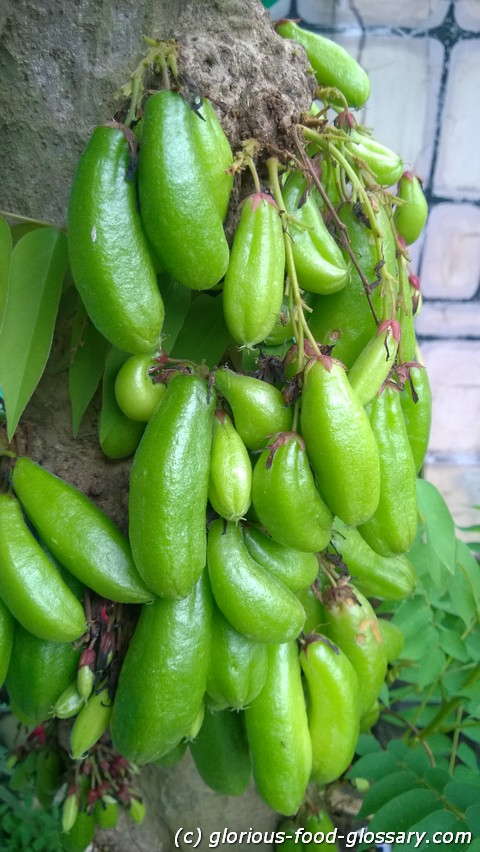Deutsch: Eibischfrucht / Español: Fruta de Averrhoa bilimbi / Português: Fruta de caramboleira / Français: Fruit de l'arbre à étoiles / Italiano: Frutto di Averrhoa bilimbi /
Kamias is a Filipino fruit with scientific name Averrhoa bilimbi. The fruit is green and edible, about four (4) centimeters long, subcylindric with five (5) obscure, broad, rounded, longitudinal lobes. Kamias is used as common seasoning for sweets and pickling and souring agent for some traditional Filipino dish called Sinigang and Paksiw.
In English, Kamias is known as the cucumber tree or Sorrel tree. This tropical tree is found in the Philippines and other Asian countries like Malaysia and Indonesia. Kamias fruit is used both for cooking and traditional medicine. Kamias is a highly acidic fruit, it can be consumed and made into a sweet preserve or jams after certain preparations are taken.
Due to the acidic nature of Kamias fruit, it is quite sour and not often eaten raw. However, in the Philippines, some are eating it raw by dipping it in salt, some made them as dipping sauce, too. The fruit is also cut into pieces and dry and used as a souring agent for some dishes. In Costa Rica, the fruit is used as a relish.
Kamias can be used as a substitute for vinegar, used in juices like lemonade, or even combined with large amounts of sugar to make jams.
Kamias provides certain amounts of vitamins and minerals.
Kamias one of the souring agents used in the Philippines is various dishes, such as Sinigang, Paksiw and Pinangat. Kamias that grow on clusters in its tree is the fruit of tree called Averrhoa balimbi. Aside for its primary use as souring agent. The Kamias fruits can also be candied using a tedious process of removing its sour taste, though and cooked with sugar. They, can be sliced and dried under the sun to be used again as souring agent, especially in Pinangat na Isda. I also used the crushed fruits to clean the tarnish from my silver cutlery.

Here are some examples of how kamias is used in food:
-
Sinigang: A sour soup made with pork, shrimp, or fish, and vegetables such as kangkong (water spinach), tomatoes, and kamias.
-
Adobo: A Filipino dish made with meat (usually chicken or pork) cooked in a mixture of vinegar, soy sauce, garlic, and kamias.
-
Pickles: Kamias can be pickled in vinegar, salt, and sugar, and used as a condiment or side dish.
-
Sambal: A spicy condiment made with chili peppers, shrimp paste, and kamias, commonly used in Indonesian cuisine.
-
Chutney: A condiment made with kamias, sugar, and spices, commonly used in Indian cuisine.
Other foods that are similar to kamias include:
-
Tamarind: A sour fruit commonly used as a souring agent in many Southeast Asian and Indian dishes.
-
Lime: A citrus fruit that has a sour flavor and is commonly used in many dishes and beverages.
-
Calamansi: A small, sour citrus fruit commonly used in Filipino cuisine.
-
Green mango: An unripe mango that has a sour flavor and is commonly used in salads and as a condiment.
-
Sorrel: A leafy vegetable that has a sour flavor and is commonly used in Caribbean and African cuisines.
Related Articles to the term 'Kamias' | |
| 'Puno ng Kamias' | ■■■■■■■■■■ |
| Puno ng Kamias refers to the tree bearing kamias (Averrhoa bilimbi), a tropical fruit native to Southeast . . . Read More | |
| 'Batwan / Batuan' | ■■■■■■■ |
| Batwan / Batuan: Batwan refers to a green sour fruit which is used as a souring agent for making Sinigang . . . Read More | |
| 'Duhat' | ■■■■■■ |
| Duhat refers to one of the fruits found and grown in the Philippines. It is called in English with various . . . Read More | |
| 'Sinigang na Baboy' | ■■■■■■ |
| Sinigang na Baboy is a classic Filipino dish known for its sour and savory flavors, primarily featuring . . . Read More | |
| 'Sampalok' | ■■■■■■ |
| Sampalok is a Filipino word for Tamarind. In the Philippines its pulp/fruit are eaten and used as a souring . . . Read More | |
| 'Kalamansi / Calamansi' | ■■■■■■ |
| Kalamansi / Calamansi: Kalamansi (Scientific name: Citrus microcarpa) refers to a small and round lime . . . Read More | |
| 'Okra' | ■■■■■■ |
| Indian: Vendakka Okra, known in many English-speaking countries as lady\'s fingers, bhindi or gumbo, . . . Read More | |
| 'Batuan' | ■■■■■■ |
| Batuan is a tropical fruit primarily used as a souring agent in Filipino cuisine. This small, green fruit . . . Read More | |
| 'Kaimito / Caimito' | ■■■■■■ |
| Kaimito / Caimito: Kaimito (Scientific name: Chrusophillum cainito) also spelled Caimito. It is called . . . Read More | |
| 'Aratilis' | ■■■■■ |
| Aratilis in the food context refers to a small, sweet fruit known by various names in different regions, . . . Read More | |
